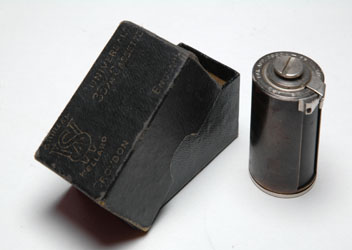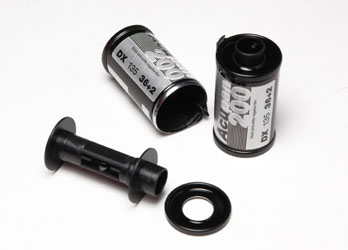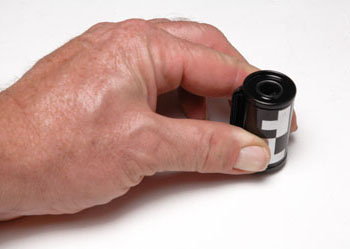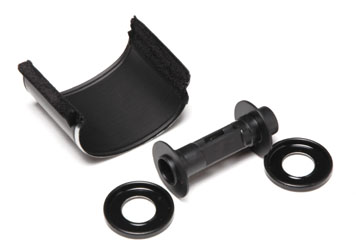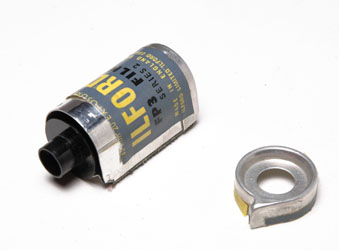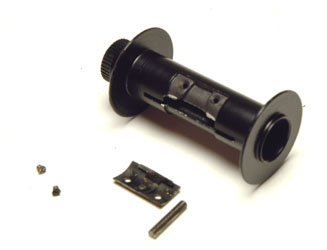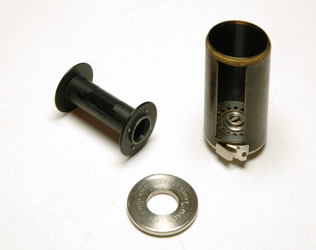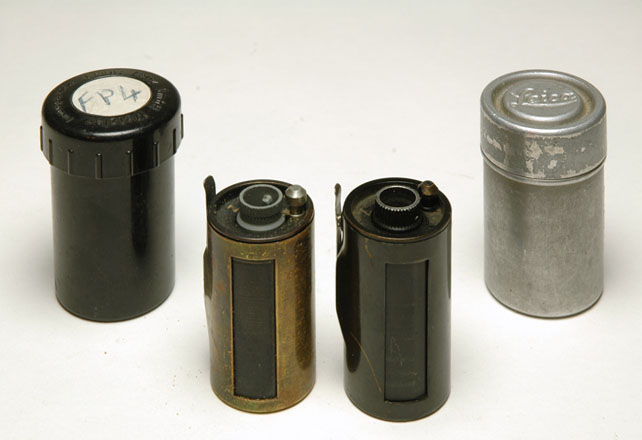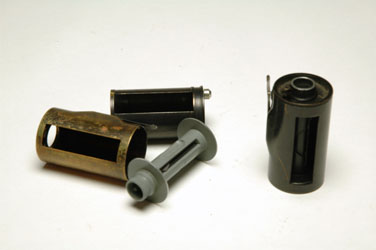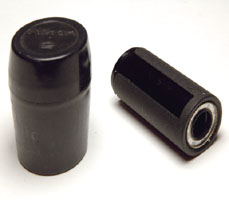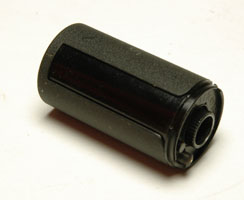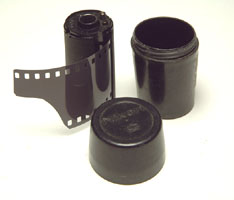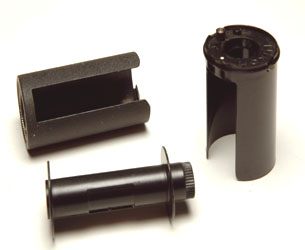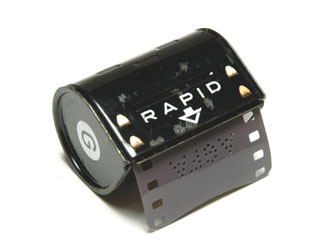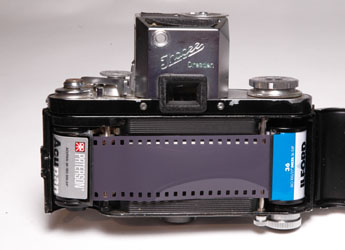The vast majority of cassettes for 35mm cameras can be divided into two types, the sort with a fixed velvet-lip light trap and the labyrinthine type. We vastly prefer the latter, for reasons that will become apparent below. There is also a residual category, usually camera-specific though the Agfa Rapid cassette was used in a surprisingly wide variety of cameras, not just from Agfa.
loading
The basic question is getting the right length of film on the centre spool, wound emulsion in. Don’t laugh: when Roger was given 800 feet of outdated FP3 in 1966, he more than once loaded it ‘backwards’ with the emulsion out, so all exposures were made through the base of the film. We’ll come back to film lengths later.
There are two possibilities: load the spool ‘naked’, then put it into the cassette, or load the spool inside the cassette.
With velvet-lip cassettes we generally prefer to load the spool outside the cassette, as it means one less trip through the velvet light trap with attendant risk of scratching, grit collecting and wear on the trap. With labyrinthine cassettes this is less of a problem and if you use a bulk loader (see below) then you will almost certainly find it easier to load the spool inside the cassette. Also, loading the spool ‘naked’ means you have to hold on pretty tightly when you cut the film, or it unwinds all over the place. Shirley Wellard ‘Universal’ labyrinthine cassette (see below) |
|
velvet lip
This is the familiar standard cassette that was introduced in the early 1930s, and is most widely used today. It has appeared in three main forms.
staked end
The most common current form for factory-loaded film is the so-called ‘staked end’ type where the end cap is so tightly crimped onto the main body of the cassette that it is difficult to remove it without damaging the end-cap or the cassette body or both, rendering reuse of the cassette problematic.
Contrary to widespread mutterings, the staked-end design was not to stop people re-using the cassettes. Rather, it was to reduce the risk of the end-cap popping off if the cassette was dropped, an important factor in professional use. Roger recalls only too well working late into the night in the early 1970s, duplicating slides for an AV presentation. By midnight he was just finishing but he was dog-tired; so tired that he knocked one of the exposed cassettes on the floor. The end popped off and he had to reshoot 36 frames. Recycling manufacturers’ cassettes Paterson Acupan was made by Foma and is still available as Fomapan Creative 200 — an excellent film, even before you recycle the cassettes. pop-off end-capOlder designs (still used by some film manufacturers) allow the end cap to be popped on and off a number of times, allowing limited re-use of the cassette. Opening the cassette Press down firmly on the long end of the spool and the cap at the opposite end should pop off. purpose-made re-usable cassettesCassettes that are designed to be re-used have either pop-on caps (like the ones used by some film manufacturers) or even twist-on plastic caps, though we have not seen these for a while. The main limiting factor with these is the life of the velvet. A piece of low-tack adhesive (Post-It note, making tape) can be used to remove grit and refresh the nap of the velvet. Cassette in pieces Although many manufacturers’ cassettes can be recycled, it is worth remembering that they were only designed for single use and are pretty flimsy. |
|
|
Ancient Ilford FP3 cassette You can see the superb light-trapping and ready re-usability that results from this design of end-cap but you can also see that it would almost certainly be a lot more expensive to manufacture and assemble than a modern pop-end cassette. |
labyrinthine
These are based on the principle that light doesn’t go around corners. There are two shells, inner and outer. Inside the camera, the two are rotated relative to one another so that there is a clear, open slot through which the film goes. For loading and unloading the camera, and for carrying the cassette, they are rotated so that the openings are anything from 90 to 180 degrees apart; the film passes between the inner and outer shells, hence ‘labyrinthine’. Opening and closing is done automatically with most designs, but with the Shirley Wellard the cassette must be opened and closed manually.
| Labyrinthine cassettes have no velvet to trap grit and cause scratches, or wear and let in light, and they can be used virtually forever: because they are so solidly made, the risk of wearing them out is negligible.
Nikon cassette centre spool Reloadable cassettes of this kind belong to an earlier age. There was a chip of film leader stuck in this one — so it took a few minutes to strip it down and reassemble it. The two tiny screws on the left hold the plate over the slot in the centre spool; the short bar is what holds the film in place in the slot. |
Their great disadvantage is that most are camera-specific (e.g. Leica, Contax, Kiev, Nikon) and fewer and fewer cameras are designed to use them: even Leicas no longer actuate the Leica self-opening cassette.
There is however one labyrinthine cassette that can be used with just about any camera that has a pull-up rewind knob, the Shirley Wellard Universal. These have not been made for decades but still turn up at camera fairs or on e-Bay, and because they are near-universal (or near-Univeral), we deal with them first.
shirley-wellard
The trick with these is the four little studs on the bottom of the film spool, clearly seen in the illustration below. Normally these sit slightly outside the corresponding holes in the bottom of the cassette, but if the spool is pushed down and twisted they engage and the inner shell can be rotated: clockwise to close (the same direction as rewinding) or anticlockwise to open. This is done by pushing down on the rewind knob and twisting in the appropriate direction.
There are only two real disadvantages. One is that the rewind knob sits very slightly proud (about 1/16 inch, 1.5mm) when the cassette is in the camera. The other is that you have to remember to open and close the cassette. The former is more often an aesthetic problem than practical, and the latter is a question of memory. Shirley-Wellard, disassembled The end cap just screws on and off. You can clearly see the four studs on the bottom of the film spool and the corresponding holes in the base-plate of the cassette. If anyone were to build such cassettes today they would probably have to sell at over a hundred pounds ($200) each; the amount of engineering in there is extraordinary. |
|
Two forms of adjustment are provided to fit the cassette to the camera: a properly-fitted Shirley Wellard fits perfectly and will not rattle at all. One is the vertical adjustment, and the other is the rotational adjustment. Both are most easily understood from Shirley-Wellard’s own instruction leaflet, reproduced on its own page.
leica
Unlike the Shirley-Wellard, where the inner and outer shell are permanently linked, the two shells of the the Leica cassette come apart for loading. The pictures will make this clear. It is important to note, though, that there are two models of Leica cassette, the early ‘black mushroom’ model for screw-mount Leicas only and the later ‘chrome mushroom’ model which can be used in all Leicas except the later M-series. We are not sure when Leicas stopped automatically opening and closing these cassettes via a key in the baseplate but they certainly don’t work in our MP with its Leicavit-M.
Leica cassettes On the left, the later ‘chrome mushroom’ variety with its correct plastic container (screw-on lid with white plate for noting film type); on the right, the earlier ‘black mushroom’ type with its correct metal container (push-on lid). Obviously the later one has had much more use! When the catch on the bottom of the Leica is turned, the spring on the left of the cassette is pushed aside, and the ‘mushroom’ — the post on the right, opposite the spring — is rotated. |
|
| Leica cassettes, disassembled and open On the left, the ‘chrome mushroom’ cassette is disassembled (some have black spools, some grey) while on the right the ‘black mushroom’ cassette is open; you can see how the spring is pushed back slightly, at which point you can rotate the ‘mushroom’, align the slots, and open the cassette. DO NOT send these cassettes to labs who are not familiar with them: we had one written off when some ham-handed cretin just bent the spring out at a right angle to open the cassette, instead of admitting he didn’t know, and asking. |
contax/kiev
These appear to be interchangeable — which is no surprise as the Kiev is essentially a Contax II/III — but we have not had the opportunity to try both kinds in both cameras. We couldn’t find our Kiev cassette which is why it isn’t illustrated here.
nikon
These are clearly based on the Contax version, which again is no surprise as the original Nikon rangefinder cameras borrowed a lot of design features from the Contax. They are easier to handle than either Shirley Wellard or Leica because the slots are open at the ends, without a ‘bridge’. Nikon cassette Open. The white end is an ISO scale film reminder. |
|
|
Nikon cassette Left, closed, empty. The button at the bottom of the end face actuates the lock. Right, loaded, with the correct Nikon screw-top plastic container. |
|
Nikon cassette disassembled Outer shell, fine black wrinkle exterior, left; inner shell, glossy black, right. If you load your own film from bulk, and if you have a camera that can accept some sort of reloadable labyrinthine cassette (whether self-opening or Shirley Wellard) they are well worth seeking out and they often go for absurdly low prices, given the amount and quality of work involved in making them. |
|
other cassettes
The Agfa Rapid system, long obsolete, had no centre spool. As far as we are aware it derives from the Ansco Memo of 1927. The film was pulled out of one cassette by the film transport mechanism, and pushed into the other where (if you were lucky) it curled up of its own accord. The old feed cassette then became the new take-up cassette. The longer the load, the harder it was to persuade it to feed properly. Anything much over 20 exposures is pushing your luck as well as the film. On the bright side, cassettes are easy to reload (but hard to clean).
| Agfa Rapid cassette You can see that there is no centre spool: the film is just pushed in to the feed cassette. The end of the film (with the perforated ‘Agfa’ is however quite heavily textured. We do not know how important this is in assisting stiffness and loading. Some Robot cassettes had a velvet light-trap but the lips of the trap were pushed apart when the camera back was closed. This allowed a tighter trap when it was closed, allowing better light sealing, and greatly reduced the risk of scratching when it was open. |
A few manufacturers have offered 250-exposure models, or 250-exposure backs, with corresponding cassettes: Leica was the earliest of the major systems to do this, but Nikon and others have done the same. The cassettes in question take about 10 metres (33 feet) of film.
Most other cassettes are even rarer, such as the extra-small cassette for Tessinas and one or two from the 1920s and very early 1930s before cassettes were standardized: in those days, every manufacturer made them to his own design.
cassette-to-cassette
A few cameras allow you to work cassette-to-cassette, whether dedicated (e.g. original Contax) or with standard velvet-lip cassettes (e.g. Exakta). This offers several advantages including the loss of only a couple of frames of exposed film if the back is opened by mistake, and minimal film loss if you want to change films in mid-roll. Loading is however slower and less convenient. Another drawback, which had not occurred to us until we tried it, is that you can end up with the film in a different cassette. Here, for example, the camera is loaded with Ilford Delta 100 (Exaktas work ‘backwards’, remember) but the film could end up in an old Acupan cassette. Devotees of Exaktas may be interested in the paid review. |
|
working without cassettes
With cameras where you do not have suitable cassettes, it is often possible to improvise some form of feed cassette (usually based on the centre spool of a standard modern cassette) and load and unload the camera in the darkroom. This is hardly convenient but if you want to try some ancient camera it is worth remembering.

